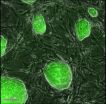(Press-News.org) STANFORD, Calif. — People who use in vitro fertilization to conceive children often have leftover embryos and must decide whether to store them, dispose of them or possibly donate them for research. A new process developed by researchers at the Stanford University School of Medicine allows these people to make this decision in the privacy of their own homes — without any interaction with clinic personnel or scientists who might benefit from the research.
"There is concern that conflicts of interest and influence by researchers and clinicians may play a role in donor choice," said bioethicist and senior author of the research, Christopher Scott, who directs Stanford's Program on Stem Cells in Society. "The Stanford biobank process allows people time to make the primary decision to donate on their own, when it's right for them. It also allowed us to ask whether donors have preferences as to the type of research they will allow on their embryos."
The study will be published April 8 in Cell Stem Cell. The study includes a description of the process as well as the results of a survey indicating which research options were selected by those who chose to donate their embryos.
People who try in vitro fertilization often find themselves with excess embryos after they either successfully conceive or abandon their attempt to have children. Researchers believe that at least several hundred thousand are stored in clinics around the country. There is routinely a monthly or yearly storage fee to keep the embryos frozen in liquid nitrogen.
Many IVF clinics offer people the option of donating their embryos for research, but the procedures vary and often involve discussions between potential donors and experts as part of the decision-making process. Many also do not specify the types of research for which the embryos could be used.
In the two-part procedure described in the study, which is now used routinely at Stanford, information about potential donation for research is included in the normal embryo-storage bill from the clinic. "At that point," Scott said, "the recipients are free to throw the information away or put it on the coffee table to consider and talk about." Only after the couple has made the initial decision to donate do they interact with Stanford biobank staff members, who use a script to confirm donation choices and answer any questions the potential donors may have.
Specifically, people who indicated that they would like to donate were sent an informed-consent packet outlining the types of research that could be done with the embryos, such as creating embryonic stem cell lines or studying human development. (Research into human development typically occurs during the first 12 days of culture, after which the embryos are no longer grown. Embryonic stem cell research entails creating stem cell lines that can be propagated indefinitely in the laboratory and may be used for both research and therapy.)
Once the potential donors had time to review the material, they then participated in a phone interview with staff members at Stanford's biobank who were unconnected with either the original in vitro fertilization clinic or the researchers who might use the embryos. Staff members followed a script to confirm the donors' preferences and make sure they understood their options — including whether they wanted to be notified if the research unearthed any genetic information that might affect their health or the health of their relatives.
"Many couples were very relieved to have the option to donate their embryos for research and to participate in the field of stem cell research," said Stanford biobank research manager and study first author Tasha Kalista.
The researchers found that donors were equally likely to give consent for their use in the creation of embryonic stem cell lines as for the study of human development.
In addition to outlining the new process, the paper also reports on the preferences of the participants. The researchers found that people who choose to donate their embryos for research are primarily concerned that they not be used to make a baby for someone else. Although people have the option to put their embryos up for "adoption," that is an entirely separate process from donating an embryo for research purposes. Nonetheless, many donors asked for reassurance.
The researchers did not have sufficient data to determine what proportion of potential donors chose to either continue storing their embryos or to dispose of them.
The researchers surveyed the preferences of 403 couples who donated 1,356 embryos to Stanford for research. The embryos had been stored at one of 40 in vitro fertilization clinics or three storage facilities in 20 states. About one-fifth of those surveyed had used donated eggs or sperm and were excluded from further analysis because consent for embryonic stem cell research would have also been required from the egg and sperm donors. Of those remaining, 32 percent gave consent for their embryos to be used only for the study of human development and 30 percent only for stem cell research. Thirty-eight percent gave consent for their embryos to be used for either type of research.
In the future, Scott and the other researchers would like to determine what proportion of potential donors choose to give embryos for research. They'd also like to find out if donors' choices are influenced by where they live.
###
Other Stanford researchers involved in the study include Renee Reijo Pera, PhD, professor of obstetrics and gynecology and director of Stanford's Center for Human Embryonic Stem Cell Research and Education; Barry Behr, PhD, professor of obstetrics and gynecology and director of Stanford's RENEW Biobank; and research associate H. Austinn Freeman. The research was funded by the California Institute for Regenerative Medicine and Stanford University.
The Stanford University School of Medicine consistently ranks among the nation's top medical schools, integrating research, medical education, patient care and community service. For more news about the school, please visit http://mednews.stanford.edu. The medical school is part of Stanford Medicine, which includes Stanford Hospital & Clinics and Lucile Packard Children's Hospital. For information about all three, please visit http://stanfordmedicine.org/about/news.html.
PRINT MEDIA CONTACT: Krista Conger at (650) 725-5371 (kristac@stanford.edu)
BROADCAST MEDIA CONTACT: M.A. Malone at (650) 723-6912 (mamalone@stanford.edu)
END
A paper published by Cell Press in the April 8th issue of the journal Cell Stem Cell reveals a new and more efficient method for reprogramming adult mouse and human cells into an embryonic stem cell-like state and could lead to better strategies for developing stem cells for therapeutic use.
The ability to reprogram adult cells into cells that resemble embryonic stem cells has tremendous potential for both stem cell research and regenerative medicine. "Previous studies have demonstrated the usefulness of iPSCs not only in the study of basic stem biology, but also in ...
PHILADELPHIA - Researchers at the University of Pennsylvania School of Medicine have devised a totally new and far more efficient way of generating induced pluripotent stem cells (iPSCs), immature cells that are able to develop into several different types of cells or tissues in the body. The researchers used fibroblast cells, which are easily obtained from skin biopsies, and could be used to generate patient-specific iPSCs for drug screening and tissue regeneration.
iPSCs are typically generated from adult non-reproductive cells by expressing four different genes called ...
Dr. Grant Stevens of Marina Plastic Surgery (www.marinaplasticsurgery.com) is seeing a rise in the popularity of facial plastic surgery procedures such as eyelid surgery and facelift in Los Angeles, but his practice is also seeing a dramatic jump in the number of nonsurgical facial rejuvenation procedures being performed. These nonsurgical procedures meet the demands of patients' busy schedules while helping them look their best and allowing them to remain on-the-go.
"My Los Angeles plastic surgery patients choose from a wide range of procedures," says Dr. Stevens, "and ...
We all know that people at opposite ends of the political spectrum often really can't see eye to eye. Now, a new report published online on April 7th in Current Biology, a Cell Press publication, reveals that those differences in political orientation are tied to differences in the very structures of our brains.
Individuals who call themselves liberal tend to have larger anterior cingulate cortexes, while those who call themselves conservative have larger amygdalas. Based on what is known about the functions of those two brain regions, the structural differences are consistent ...
Cave life is known to favor the evolution of a variety of traits, including blindness and loss of eyes, loss of pigmentation, and changes in metabolism and feeding behavior. Now researchers reporting online on April 7 in Current Biology, a Cell Press publication, have added sleeplessness to that list.
"Cave-adapted fish sleep less—much less—than closely related surface fish," said Richard Borowsky of New York University. "In some ways, their sleep phenotypes are similar to those of humans with sleep disorders."
The fish do sleep, but only for relatively short periods, ...
Cellomobile.com recently introduced a short-term Blackberry rental with an unlimited data plan designed to meet the needs of international travelers.
Cellomobile.com is currently offering an unprecedented data plan of international cell phone rental for world travelers. The plan allows world travelers to rent a late model Blackberry that works wherever they want to go. The Blackberry works as both a communication device and a modem, offering unlimited depth of coverage that includes talk, text, and web in any corner of the world.
The data plan truly is unlimited, ...
Monkeys infected with an emerging malaria strain are providing a reservoir for human disease in Southeast Asia, according to research published today. The Wellcome Trust funded study confirms that the species has not yet adapted to humans and that monkeys are the main source of infection.
Malaria is a potentially deadly disease that kills over a million people each year. The disease is caused by malaria parasites, which are transmitted by infected mosquitoes and injected into the bloodstream.
There are five species of malaria parasite that are known to cause disease ...
LA JOLLA, CA – April 7, 2011 – Slight oscillations lasting just milliseconds have a huge impact on an enzyme's function, according to a new study by Scripps Research Institute scientists. Blocking these movements, without changing the enzyme's overall structure or any of its other properties, renders the enzyme defective in carrying out chemical reactions.
The study, published in April 8, 2011 issue of the journal Science, adds to a growing body of evidence pointing to the importance of movement in the ability of enzymes and other types of proteins to do their job. The ...
Just a month after a $145K jackpot win, the Slotland.com progressive jackpot has already been hit again. Marianne M., a toy company project manager known as WYNDSTAR on the site, won $83,979 playing the Striking 7s video poker game last Friday.
"Of course the jackpot can be won anytime but we usually go six to eight weeks between wins," said Slotland Manager Michael Hilary. "It didn't have time to get up to $100K or $150K this time, like it usually does, but I'm sure the winner is happy just the same!"
Marianne M. has been playing at Slotland since March 2009. She ...
Chevy Chase, MD—Today, The Endocrine Society released a new Clinical Practice Guideline (CPG) for the evaluation and treatment of pituitary incidentalomas. The CPG is published in the April 2011 issue of the Journal of Clinical Endocrinology & Metabolism (JCEM), a publication of The Endocrine Society.
A pituitary incidentaloma is a tumor or lesion on or near the pituitary gland. It is found when a person has an imaging test for an unrelated reason. Doctors call this an "incidental" finding, meaning by chance—thus, the name incidentaloma. This surprise finding is not uncommon. ...


